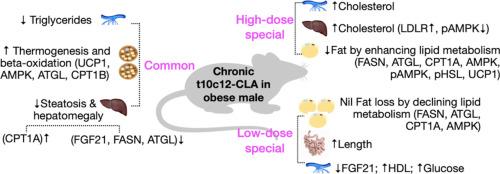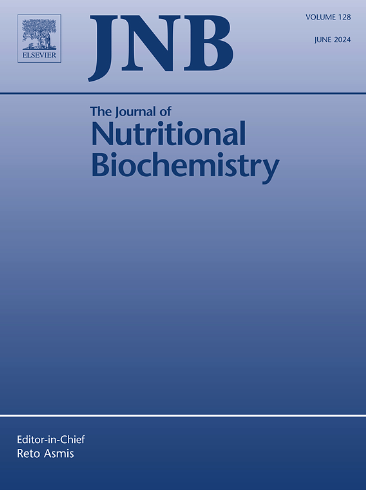Trans 10, cis 12-conjugated linoleic acid in low concentration reduces while in high concentration enhances adipocyte metabolism but effectively improves hepatic steatosis of obese mice
IF 4.8
2区 医学
Q1 BIOCHEMISTRY & MOLECULAR BIOLOGY
引用次数: 0
Abstract
Trans 10, cis 12-conjugated linoleic acid (t10c12-CLA)-producing mice were used to investigate the antiobesity of obese males. Compared to wild-type littermates, high concentration t10c12-CLA in biallelic Pai/Pai mice reduced fat by up-regulation lipid metabolism in white adipose tissue (WAT). In contrast, low concentration t10c12-CLA in monoallelic Pai/wt mice could not reduce fat for down-regulation lipid metabolism in WAT. Simultaneously, t10c12-CLA enhanced thermogenesis and beta-oxidation in brown adipose tissue, alleviated steatosis by declining lipid metabolism in the liver, and lowered circulating triglycerides. On the other hand, low concentration t10c12-CLA specifically resulted in decreased circulating fibroblast growth factor 21, elevated glucose and high-density lipoprotein, whereas high concentration t10c12-CLA specifically increased circulating and hepatic cholesterol levels via up-regulation of low-density lipoprotein receptor in the liver. In conclusion, high concentration t10c12-CLA enhances local lipid metabolism in WAT and leads to fat loss, whereas low concentration t10c12-CLA attenuates the enzymic activities in WAT and fails to reduce fat. T10c12-CLA can effectively and concentration independently improve steatosis by attenuating hepatic lipid metabolism. These results suggest that low concentration of t10c12-CLA is beneficial, but high concentration is unfavorable to obese male mammals.

低浓度的反式 10、顺式 12-共轭亚油酸会降低肥胖小鼠的脂肪细胞代谢,而高浓度的反式 10、顺式 12-共轭亚油酸则会增强脂肪细胞代谢,但却能有效改善肥胖小鼠的肝脏脂肪变性。
研究人员利用反式10,顺式12-共轭亚油酸(t10c12-CLA)小鼠来研究肥胖雄性小鼠的抗肥胖能力。与野生型小鼠相比,高浓度的t10c12-CLA能上调白色脂肪组织(WAT)的脂质代谢,从而减少脂肪。与此相反,低浓度t10c12-CLA在单等位基因Pai/wt小鼠中不能通过下调白脂肪组织的脂质代谢来减少脂肪。与此同时,t10c12-CLA 可增强棕色脂肪组织的产热和β-氧化作用,通过降低肝脏的脂质代谢缓解脂肪变性,并降低循环甘油三酯。另一方面,低浓度 t10c12-CLA 会导致循环中成纤维细胞生长因子 21 减少、血糖和高密度脂蛋白升高,而高浓度 t10c12-CLA 则会通过上调肝脏中的低密度脂蛋白受体,增加循环和肝脏中的胆固醇水平。总之,高浓度t10c12-CLA能增强脂肪组织的局部脂质代谢,导致脂肪减少,而低浓度t10c12-CLA则会削弱脂肪组织的酶活性,无法减少脂肪。T10c12-CLA 可通过减弱肝脏脂质代谢,有效地改善脂肪变性,且不受浓度影响。这些结果表明,低浓度的 t10c12-CLA 对肥胖雄性哺乳动物有益,但高浓度的 t10c12-CLA 对肥胖雄性哺乳动物不利。
本文章由计算机程序翻译,如有差异,请以英文原文为准。
求助全文
约1分钟内获得全文
求助全文
来源期刊

Journal of Nutritional Biochemistry
医学-生化与分子生物学
CiteScore
9.50
自引率
3.60%
发文量
237
审稿时长
68 days
期刊介绍:
Devoted to advancements in nutritional sciences, The Journal of Nutritional Biochemistry presents experimental nutrition research as it relates to: biochemistry, molecular biology, toxicology, or physiology.
Rigorous reviews by an international editorial board of distinguished scientists ensure publication of the most current and key research being conducted in nutrition at the cellular, animal and human level. In addition to its monthly features of critical reviews and research articles, The Journal of Nutritional Biochemistry also periodically publishes emerging issues, experimental methods, and other types of articles.
 求助内容:
求助内容: 应助结果提醒方式:
应助结果提醒方式:


